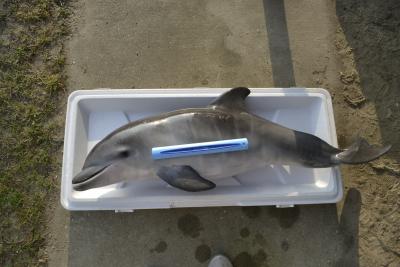Dolphin Deaths Investigated by Southern Miss Marine Science Researchers
Wed, 07/18/2012 - 04:09pm | By: David Tisdale

Scientists with The University of Southern Mississippi Department of Marine Science are part of a collaboration of colleagues from Dauphin Island Sea Lab and the University of Central Florida that last year examined a mysterious case of dolphin deaths along the Gulf Coast.
From January to April 2011, 186 dolphins washed ashore from Louisiana to western Florida and areconsidered part of an “unusual mortality event” or UME by the National Oceanographic and Atmospheric Administration (NOAA). Of particular concern among the scientists examining this issue is the high number of young dolphins making up nearly 46 percent of the deaths. An article spotlighting this research will appear in the journal PLoS-ONE.
Although the strandings occurred shortly after the BP Deepwater Horizon disaster, the acute cause of death remains undetermined.
“We believe several factors, including bacterial infections and a loss of prey during the oil spill, contributed to the poor health of these marine animals,” said Dr. Monty Graham, chairman of the Southern Miss Department of Marine Sciences and a member of the consortium.
Graham and other consortium scientists examined condition and location of the dolphin carcasses, including the time frame of their stranding. The number of ‘perinatal' (near birth) dolphins stranded during this four-month period is six times higher than the average number of perinatal strandings in the region since 2003, and nearly double the historical percentage of all strandings.
According to the study's lead author, Dr. Ruth Carmichael, from the Dauphin Island Sea Lab, targeted analyses of tissues from stranded dolphins are essential in assessing a cause of death. But the research team hopes their findings highlight the importance of considering environmental data along with biological samples to interpret stranding patterns.
The majority of perinatal strandings were centered on the Mississippi-Alabama coast, adjacent to Mobile Bay, the fourthlargest freshwater drainage in the U.S. Although nearshore areas are regularly influenced by freshwater drainage, the watershed had experienced moderate to severe drought for several years.
Following a particularly cold winter and the Deepwater Horizon oil spill in 2010, the sudden entry of high volumes of cold freshwater from Mobile Bay imposed additional stress on the ecosystem. Onshore movement of surface currents during the same period resulted in animals washing ashore where freshwater pules called “freshlets” were most intense.
The researchers contend the dolphins were unable to swim away from the cold freshwater because of their compromised health.
“Surface currents, measured by coastal radars of USM's Central Gulf of Mexico Ocean Observing System, indicated that onshore flow at the time of the freshets would have helped to keep that cold water near the coast,” said Southern Miss associate professor of marine science Dr. Stephan Howden, who contributed to the research effort.
Learn more about the Southern Miss Department of Marine Science at www.usm.edu/marine